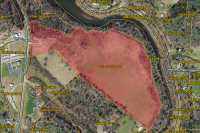Testing points to potential sediment runoff issues at quarry
Water pollution stemming from a Waynesville rock quarry is 100 times higher than that allowed under state standards, according to recent creek sampling by a state water quality specialist.
Silt running off the Harrison Construction rock quarry into nearby Allens Creek during rainstorms is evident to the naked eye.
“It looks like buttermilk after a good hard rain,” said Charles Miller, who lives along Allens Creek downstream of the quarry.
Miller says it is nothing new. But until last week, state water quality inspectors had not visited the quarry since 2006 — despite renewing the quarry’s five-year water quality permit earlier this year.
Water samples taken immediately upstream and downstream of the rock quarry during a recent rainstorm show a huge spike in turbidity levels that far exceed the state’s standard (see chart).
Neighbors of the quarry have complained loudly about the volume of mud pouring into Allens Creek as part of a larger fight against expansion of the quarry, prompting the action from environmental agencies.
Related Items
Downstream neighbors of the quarry deserve credit for shedding light on water quality problems, said Eric Romaniszyn, director of the non-profit Haywood Waterways Association.
“It takes a small group, mostly people who live in an area, to speak up,” Romaniszyn said.
Michael Rogers, who lives in the shadow of the quarry, photographed Allens Creek upstream and downstream of the quarry following rainstorms and submitted the visible evidence of excessive erosion to the state mining bureau in Raleigh, which controls the quarry’s permit.
That alone did not spur a site visit by inspectors, however. Instead, residents convinced a water quality specialist coordinating an ecological restoration of Richland Creek — a major stream that courses through Waynesville — to capture the water samples. Since pollution in Allens Creek eventually ends up in Richland Creek, Ed Williams told residents near the quarry to call him the next time it rained.
Williams is not technically an inspector, but works under the N.C. Division of Water Quality regional office in Asheville. He promptly shared his results with rest of his office, and that in turn triggered an official inspection the following week.
“When we saw those results, we wanted to find out what is happening,” said Roger Edwards, the regional supervisor for the Division of Water Quality out of Asheville. “There may be issues out there.”
The official inspection report will not be available for another week.
Edwards does not believe the erosion from the quarry could sideline the expansion permit. The quarry can shore up its erosion safeguards — indeed it will be required to if violations are noted, Edwards said — negating any long-term impacts.
Doing their best
Edwards said it can be a challenge to manage erosion at quarries.
“The more vegetation you remove, the more you increase your stormwater runoff, and the more impacts it is going to have,” Edwards said.
And quarries, by nature, have little vegetation. The Allens Creek quarry is permited to disturb up to 137 acres. Roughly half that acreage is the mining pit itself, while the other half is stockpiles, the crushing yard, roads and the like.
Ditches are supposed to funnel mud-laden rainwater running off the quarry’s bare slopes into retention ponds. When working correctly, the silt settles to the bottom of the ponds and clean water continues on through a storm drain to the creek.
But inspectors can’t always tell just by looking whether the erosion safeguards are doing their job.
“You have to be out there during a rainfall event, and you have to sample, and realistically, you have to get more than one sample,” Edwards said.
But the Division of Water Quality doesn’t have the staff to inspect every site under its purview in the course of a calendar year — let alone when it is raining. Edwards said his staff of 12 is in charge of 800 permits spanning 19 counties.
Edwards said inspectors aim to visit every site once during the span of the permit — in the case of the quarry, that’s once every five years. Even then, it may be on a sunny day and typically does not entail water sampling.
“It is a staffing issue and workload management issue,” Edwards said.
Edwards said the frequency of inspections at a site is based in part on its history. But when inspections are few and far between, violations can go unnoticed. The site stays off the offender list, reinforcing the less-frequent inspection schedule.
Quarries are supposed to conduct their own creek sampling twice a year and keep a log of erosion control efforts. Quarry managers are supposed to notify water quality inspectors anytime sediment is visibly seen running off the site into a creek, according to the terms of their water quality permit.
Haywood Waterways Association collects samples from Allens Creek monthly as part of its countywide water quality observations. Turbidity has been well within state standards, although the samples are taken a couple of miles downstream from the quarry and on days when it hasn’t necessarily been raining.
While data shows the creek looks good under normal conditions, even a temporary spike in turbidity on a short section of stream qualifies as a violation.
Dual oversight
The quarry has three state permits with three separate state agencies: water quality, air quality and land quality. All three fall under the larger umbrella of the N.C. Department of Environment and Natural Resources.
“There is overlap from agency to agency,” Rogers said.
However, inspectors with the land quality division — who monitor compliance with the quarry’s main mining permit and erosion control plan — went 3.5 years without doing an inspection, from 2005 to 2008.
Their counterparts in the water quality division went four years without visiting the site, from 2006 until last week.
Inspectors with land quality told the quarry it needed to take “corrective action” with certain erosion safeguards three times from 2008 and 2009, according to inspection reports. However, there were no specific follow-up visits to see that corrections were made.
Complaints from neighbors fighting the quarry expansion prompted three inspections by the land quality division in the past three months alone. The inspector, Shawna Riddle, was called out specifically due to complaints of sediment in the stream, but she ruled the quarry was in compliance with its sediment and erosion control plan and found no violations.
“Site was in compliance. All discharge points inspected and no violations noted,” Riddle wrote in an inspection report dated June 7.
But nine days later, water samples taken from Allens Creek portrayed a different reality.
Edwards, who works in the same office as Riddle but on the water quality side, could not explain the incongruous reports: one by land quality showing no violations, and another by water quality nine days later documenting excessive turbidity.
At a public hearing on the rock quarry expansion two weeks ago, quarry workers accused opponents of trying to shut operations down.
“They just think it is unsightly, and they want to get rid of it,” said Michael Mathis. “It was here before they were here, and it will be here when they are gone unless they make it too tough. If it does close, it doesn’t bother them — they will all be happy, slapping each other on the back up there.”
Neighbors say that’s not their motive.
“I don’t want to shut them down. I just want them to go by the law,” Miller said.









